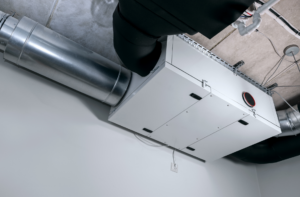Maintaining good indoor air quality and energy efficiency in your home is essential for your family’s comfort and well-being. One way to significantly enhance your living environment is by integrating heat recovery ventilators (HRVs) or energy recovery ventilators (ERVs) into your existing HVAC system. These innovative solutions are designed to help control your home’s humidity levels, ensure proper ventilation, and reduce energy consumption without sacrificing comfort.
Heat and energy recovery ventilators work by exchanging stale, polluted indoor air with fresh, filtered outdoor air, providing a continuous flow of healthy air throughout your home. By efficiently recovering heat and energy from the exhaust air stream, these systems can help reduce the load on your HVAC system, resulting in increased energy efficiency, lower utility bills, and a more comfortable living environment. While HRVs primarily focus on transferring heat energy, ERVs also transfer moisture, making them an excellent choice in regions with more extreme temperature and humidity fluctuations.
In addition to improving indoor air quality, the use of heat and energy recovery ventilators can lead to other benefits, such as increased HVAC system efficiency, reduced allergen levels, and enhanced moisture control. Stay tuned as we further explore the advantages, differences, and applicability of HRVs and ERVs, along with tips for selecting and maintaining these systems in your home.
1. Benefits of Heat and Energy Recovery Ventilators
Heat recovery ventilators (HRVs) and energy recovery ventilators (ERVs) offer numerous advantages for homeowners seeking to improve their home’s indoor environment, including:
- Improved Indoor Air Quality: By supplying a continuous stream of fresh, filtered outdoor air and removing stale, polluted indoor air, HRVs, and ERVs help to maintain an optimal indoor atmosphere, free of harmful pollutants and allergens.
- Enhanced HVAC System Efficiency: HRVs and ERVs can reduce the load on your heating and cooling system by recovering heat and energy from the exhaust air, leading to greater energy efficiency and potentially lower energy bills.
- Increased Moisture Control: By regulating humidity levels within your home, heat, and energy recovery ventilators can prevent issues such as mold growth, excess condensation, and damage to your home’s structure and furnishings.
- Healthier Living Environment: By controlling indoor contaminants and providing improved ventilation, HRVs and ERVs contribute to a cleaner, fresher living space that supports the well-being of your family.
2. Differences Between HRVs and ERVs
While heat recovery ventilators (HRVs) and energy recovery ventilators (ERVs) have many similarities, there are key differences in their functionality that make one system more suitable for specific applications and climates:
- Heat Transfer: Both HRVs and ERVs transfer heat between the incoming and outgoing air streams. However, HRVs are designed solely for heat exchange, making them ideal for regions with moderate temperature fluctuations.
- Moisture Transfer: Energy recovery ventilators (ERVs) have the added capability of transferring moisture between the incoming and outgoing air streams. This additional function allows ERVs to regulate humidity levels more effectively, making them well-suited for areas with extreme temperature and humidity variations.
- Energy Efficiency: Generally, ERVs tend to be slightly more energy-efficient than HRVs due to their moisture transfer capabilities, which can also help to reduce the load on your air conditioning system during hot, humid months.
3. Selecting the Right Ventilator for Your Home
Determining whether an HRV or ERV is the best solution for your home depends on several factors, such as your climate, home size, and ventilation requirements. When choosing between HRVs and ERVs, consider the following aspects:
- Climate: If you live in a region with extreme temperature and humidity fluctuations, an energy recovery ventilator (ERV) may be the better choice due to its moisture transfer capabilities. On the other hand, a heat recovery ventilator (HRV) may be more suitable for homes in areas with milder climates and moderate temperature variations.
- Home Size: The size of your home and the number of occupants will affect your ventilation and air quality needs. Our professionals can help assess your home’s requirements and recommend an appropriately sized HRV or ERV system to suit your needs.
- Existing HVAC System: Before selecting a heat or energy recovery ventilator, it’s essential to evaluate your current HVAC system’s compatibility and ensure that it can support the additional components of an HRV or ERV system.
4. Maintaining Your HRV or ERV System
Proper maintenance of your heat or energy recovery ventilator is key to ensuring its efficient operation and prolonging its lifespan. Our technicians recommend the following maintenance tips for HRVs and ERVs:
- Regular Filter Cleanings: Over time, filters in HRVs and ERVs can become clogged with dust and debris, affecting their performance. Be sure to clean or replace your system’s filters according to the manufacturer’s guidelines to ensure optimal indoor air quality and energy efficiency.
- Ventilation System Inspections: Schedule an annual inspection of your HRV or ERV system by our trained professionals to check for any issues, such as leaks, component wear, or improper airflow.
- Periodic Cleaning and Servicing: To maintain your heat or energy recovery ventilator’s performance and efficiency, it’s important to periodically clean and service its components, such as the heat exchanger, fans, and ventilation ducts.
Conclusion
Investing in a heat or energy recovery ventilator can greatly enhance your home’s indoor air quality, energy efficiency, and overall comfort. By partnering with the experts at Dirks Heating & Cooling Inc, you’ll receive the guidance and support you need to make an informed decision and ensure the proper installation and maintenance of your HRV or ERV system. Contact us today to explore the possibilities of integrating a heat or energy recovery ventilator into your home’s HVAC system with our HVAC services in Barron.






